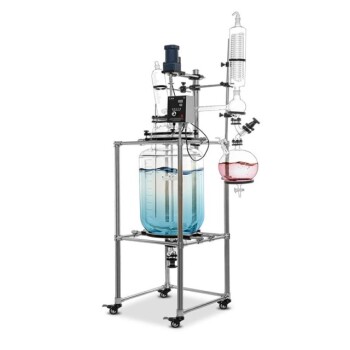Before using a rotary evaporator, it is essential to perform a series of checks and preparations to ensure safe and efficient operation. These include assembling the equipment correctly, ensuring all components are secure, and verifying that the system is leak-free. Additionally, precautions must be taken to prevent accidents, such as avoiding entanglement with rotating parts, managing hazardous materials carefully, and ensuring proper ventilation. Proper setup and adherence to safety protocols will minimize risks and optimize the performance of the rotary evaporator.
Key Points Explained:

-
Assemble and Inspect the Equipment:
- Assemble the rotary evaporator according to the schematic diagram, ensuring all connections are secure.
- Check for any visible damage or wear on components such as the flask, condenser, and tubing.
- Ensure that the solvent collection flask is empty to avoid mixing incompatible chemicals, which could lead to dangerous reactions.
-
Secure Rotating Parts and Prevent Entanglement:
- Avoid wearing loose clothing, jewelry, or having loose hair near the apparatus to prevent entanglement with rotating parts.
- Use Keck clips or metal clamps to secure the bump trap or flask, ensuring they are firmly attached and will not detach during operation.
-
Prepare the Cooling and Vacuum Systems:
- Turn on the cooling chiller and ensure the coolant water intakes are open to maintain proper condenser function.
- Connect and activate the vacuum pump, ensuring the vacuum gauge reaches and maintains the required pressure.
- For corrosive or volatile materials, consider using a secondary liquid nitrogen trap or a scrubber filled with paraffin oil to capture harmful vapors.
-
Check for Leaks and Proper Sealing:
- Before starting, ensure the system is properly sealed to prevent air leaks, especially when working with air-reactive materials. Leaks can draw air into the apparatus, potentially causing violent reactions.
- Test the vacuum system by observing the vacuum gauge to confirm it maintains the maximum vacuum for a period of time.
-
Set Up the Water Bath and Rotation Speed:
- Partially immerse the flask in the water bath, ensuring the temperature is set below the solvent's boiling point to prevent bumping or foaming.
- Adjust the rotation speed of the flask to prevent liquid projection. Use the monitor to control the speed carefully, especially when handling samples prone to bumping, such as ethanol.
-
Manage Hazardous Materials and Ventilation:
- Avoid inhaling toxic volatiles, especially when working with chlorinated solvents or acids. Use a fume hood or vent the system appropriately.
- Collect volatile solvents using liquid nitrogen or dry-ice condensers to ensure they are safely trapped and do not escape into the laboratory atmosphere.
-
Final Checks Before Operation:
- Double-check that all connections are secure and that the system is leak-free.
- Ensure the bump trap is in place to prevent the solution from splashing into the condenser, which could contaminate the system.
- Confirm that the vacuum and stopcock are properly adjusted to vent after solvent discharge.
-
Post-Operation Procedures:
- After evaporation, release the vacuum and stop the spinning to safely disassemble the apparatus.
- Clean the bump trap and empty the receiving flask to prepare for the next use.
- Inspect the equipment for any signs of wear or damage and address any issues before the next operation.
By following these steps and precautions, you can ensure the safe and effective use of a rotary evaporator, minimizing risks and achieving optimal results in your experiments.
Summary Table:
| Step | Key Actions |
|---|---|
| Assemble and Inspect Equipment | Secure connections, check for damage, and ensure the solvent flask is empty. |
| Secure Rotating Parts | Avoid loose clothing, use Keck clips or clamps to secure components. |
| Prepare Cooling and Vacuum Systems | Turn on the chiller, activate the vacuum pump, and use traps for volatile materials. |
| Check for Leaks | Ensure proper sealing and test the vacuum system for leaks. |
| Set Up Water Bath and Rotation | Adjust temperature and rotation speed to prevent bumping. |
| Manage Hazardous Materials | Use fume hoods, traps, and proper ventilation for toxic volatiles. |
| Final Checks Before Operation | Double-check connections, bump trap placement, and vacuum adjustments. |
| Post-Operation Procedures | Release vacuum, clean equipment, and inspect for wear or damage. |
Need help setting up your rotary evaporator? Contact our experts today for guidance and support!















